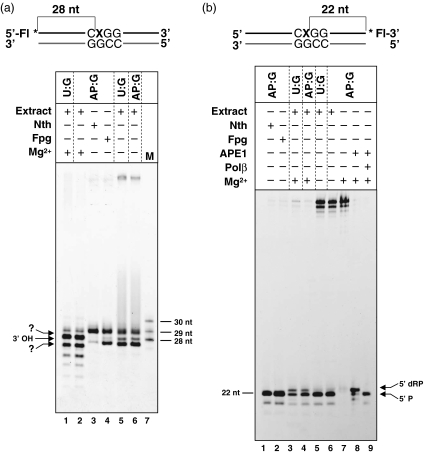Figure 3.
AP sites generated after uracil excision are processed both by AP endonucleases and AP lyases. (a) Analysis of 3′ termini. DNA duplexes containing either U or a natural AP site at the 5′ end-labeled upper strand were incubated at 30°C for 3 h with different combinations of Arabidopsis cell extract, Escherichia coli Nth (13 ng), E. coli Fpg (20 ng) and MgCl2 (5 mm), as indicated. Reaction products were separated in a 12% denaturing polyacrylamide gel, and detected by fluorescence scanning. Size markers corresponding to 28, 29 and 30 nt were loaded on lane 7. Fragments corresponding to β- and δ-elimination products, and to 3′-OH termini are indicated by arrows. (b) Analysis of 5′ termini. DNA duplexes containing either U or a natural AP site at the 3′ end-labeled upper strand were incubated at 30°C for 3 h with different combinations of Arabidopsis cell extract, E. coli Nth (13 ng), E. coli Fpg (20 ng), human APE1 (10 U), human Pol β (2.4 U) and MgCl2 (5 mm), as indicated. Reaction products were stabilized by reduction with NaBH4, separated in a 12% denaturing polyacrylamide gel and then detected by fluorescence scanning. Fragments corresponding to 5′-deoxyribose-5-phosphate (5′-dRP) and 5′-phosphate (5′-P) products are indicated by arrows.

